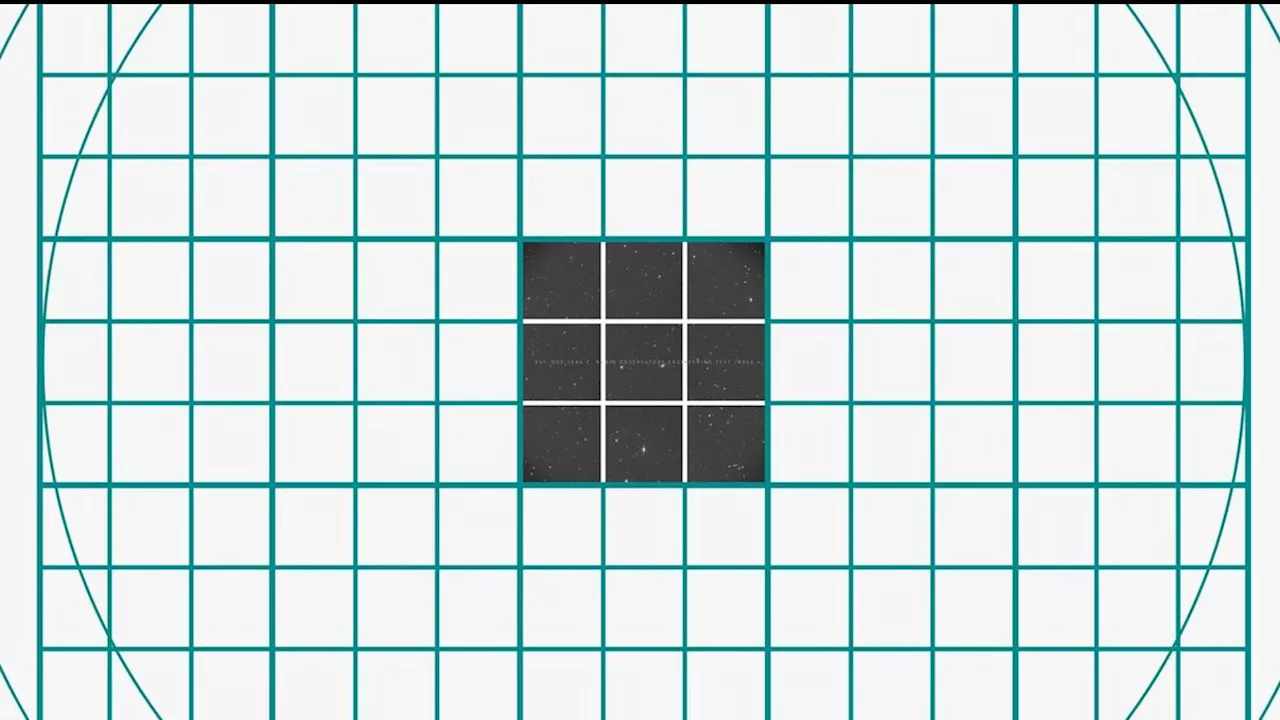NASA's Europa Clipper spacecraft has captured its first images of space, showcasing a starfield containing the constellation Corvus. These images, taken by the spacecraft's star tracker cameras, are crucial for orienting the spacecraft during its long journey to Jupiter's moon Europa.
This mosaic of a star field was made from three images captured Dec. 4, 2024, by star tracker cameras aboard NASA ’s Europa Clipper spacecraft. Showing part of the constellation Corvus, it’s the first imagery of space the orbiter has captured since its launch on Oct. 14, 2024.This version of a mosaic captured by the star tracker cameras aboard NASA ’s Europa Clipper on Dec. 4, 2024, features the names of stars within view of the cameras.
The spacecraft’s star trackers help engineers orient the orbiter throughout its long journey to Jupiter’s icy moon Europa. Three months after its launch from NASA’s Kennedy Space Center in Florida, the agency’s Europa Clipper has another 1.6 billion miles (2.6 billion kilometers) to go before it reaches Jupiter’s orbit in 2030 to take close-up images of the icy moon Europa with science cameras. Meanwhile, a set of cameras serving a different purpose is snapping photos in the space between Earth and Jupiter. Called, the two imagers look for stars and use them like a compass to help mission controllers know the exact orientation of the spacecraft — information critical for pointing telecommunications antennas toward Earth and sending data back and forth smoothly.’s first imagery of space. The picture, composed of three shots, shows tiny pinpricks of light from stars 150 to 300 light-years away. The starfield represents only about 0.1% of the full sky around the spacecraft, but by mapping the stars in just that small slice of sky, the orbiter is able to determine where it is pointed and orient itself correctly. The starfield includes the four brightest stars — Gienah, Algorab, Kraz, and Alchiba — of the constellation Corvus, which is Latin for “crow,” a bird in Greek mythology that was associated with Apollo. Engineers on NASA’s Europa Clipper mission work with the spacecraft’s star trackers in a clean room at the agency’s Jet Propulsion Laboratory in 2022. Used for orienting the spacecraft, the star trackers are seen here with red covers to protect their lenses.Besides being interesting to stargazers, the photos signal the successful checkout of the star trackers. The spacecraft checkout phase has been going on since Europa Clipper“The star trackers are engineering hardware and are always taking images, which are processed on board,” said Joanie Noonan of NASA’s Jet Propulsion Laboratory in Southern California, who leads the mission’s guidance, navigation and control operations. “We usually don’t downlink photos from the trackers, but we did in this case because it’s a really good way to make sure the hardware — including the cameras and their lenses — made it safely through launch.” Pointing the spacecraft correctly is not about navigation, which is a separate operation. But orientation using the star trackers is critical for telecommunications as well as for the science operations of the mission. Engineers need to know where the, which will collect images that will help scientists map and examine the moon’s mysterious fractures, ridges, and valleys. For at least the next three years, EIS has its protective covers closed. Europa Clipper carries nine science instruments, plus the telecommunications equipment that will be used for a gravity science investigation. During the mission’s 49 flybys of Europa, the suite will gather data that will tell scientists if the icy moon and its internal ocean have the conditions to harbor life.(85 million kilometers) from Earth, zipping along at 17 miles per second (27 kilometers per second) relative to the Sun, and soon will fly by Mars. On March 1, engineers will steer the craft in a loop around the Red Planet, using its gravity to gain speed.Europa Clipper’s three main science objectives are to determine the thickness of the moon’s icy shell and its interactions with the ocean below, to investigate its composition, and to characterize its geology. The mission’s detailed exploration of Europa will help scientists better understand the astrobiological potential for habitable worlds beyond our planet. Managed by Caltech in Pasadena, California, JPL leads the development of the Europa Clipper mission in partnership with the Johns Hopkins Applied Physics Laboratory in Laurel, Maryland, for NASA’s Science Mission Directorate in Washington. APL designed the main spacecraft body in collaboration with JPL and NASA’s Goddard Space Flight Center in Greenbelt, Maryland, NASA’s Marshall Space Flight Center in Huntsville, Alabama, and Langley Research Center in Hampton, Virginia. The Planetary Missions Program Office at Marshall executes program management of the Europa Clipper mission. NASA’s Launch Services Program, based at Kennedy, managed the launch service for the Europa Clipper spacecraft
EUROPE CLIPPER NASA SPACE EXPLORATION STAR TRACKERS JUPITER EUROPA ASTRONOMY SCIENCE MISSIONS
United States Latest News, United States Headlines
Similar News:You can also read news stories similar to this one that we have collected from other news sources.
 The Fantastic Four: First Steps Trailer Delivers First Looks at Marvel's First FamilyThe highly anticipated trailer for The Fantastic Four: First Steps has finally arrived, offering fans a sneak peek into the MCU's newest adventure. The trailer showcases the iconic superhero team, led by a stellar cast including Pedro Pascal as Reed Richards, and teases the introduction of the formidable villain Galactus.
The Fantastic Four: First Steps Trailer Delivers First Looks at Marvel's First FamilyThe highly anticipated trailer for The Fantastic Four: First Steps has finally arrived, offering fans a sneak peek into the MCU's newest adventure. The trailer showcases the iconic superhero team, led by a stellar cast including Pedro Pascal as Reed Richards, and teases the introduction of the formidable villain Galactus.
Read more »
 Madison Keys Captures First Grand Slam Title at Australian OpenMadison Keys finally achieved her Grand Slam dream, defeating Aryna Sabalenka in a thrilling three-set final at the 2025 Australian Open. This victory marks Keys' first major title at the age of 29, making her the oldest woman to achieve this feat since 2015.
Madison Keys Captures First Grand Slam Title at Australian OpenMadison Keys finally achieved her Grand Slam dream, defeating Aryna Sabalenka in a thrilling three-set final at the 2025 Australian Open. This victory marks Keys' first major title at the age of 29, making her the oldest woman to achieve this feat since 2015.
Read more »
 World's First Audio Recording of a Meteorite Crash Captures Unprecedented SoundA doorbell camera in Canada captured the world's first audio recording of a meteorite impact, providing scientists with a unique opportunity to study the sound of such an event. The meteorite, named the Charlottetown Meteorite, landed in Marshfield, Prince Edward Island, last July. Analysis of the recovered fragments revealed they were ordinary chondrites, the most common type of stony meteorite.
World's First Audio Recording of a Meteorite Crash Captures Unprecedented SoundA doorbell camera in Canada captured the world's first audio recording of a meteorite impact, providing scientists with a unique opportunity to study the sound of such an event. The meteorite, named the Charlottetown Meteorite, landed in Marshfield, Prince Edward Island, last July. Analysis of the recovered fragments revealed they were ordinary chondrites, the most common type of stony meteorite.
Read more »
 Melania Trump's Official Portrait Captures a Serious and Professional First LadyMelania Trump's official portrait, released by the White House, showcases a serious and professional demeanor. The black and white image, taken by Régine Mahaux, highlights Melania's focus and determination as she embarks on her second term as First Lady.
Melania Trump's Official Portrait Captures a Serious and Professional First LadyMelania Trump's official portrait, released by the White House, showcases a serious and professional demeanor. The black and white image, taken by Régine Mahaux, highlights Melania's focus and determination as she embarks on her second term as First Lady.
Read more »
 Ukraine Captures First North Korean Soldiers AliveUkrainian president Volodymyr Zelensky said that troops Pyongyang sent to fight in Kursk had been captured.
Ukraine Captures First North Korean Soldiers AliveUkrainian president Volodymyr Zelensky said that troops Pyongyang sent to fight in Kursk had been captured.
Read more »
 Vera Rubin Observatory Captures First Images, Ushering in a New Era of AstronomyThe Vera Rubin Observatory in Chile has successfully completed its initial systems tests and captured its first engineering images, marking a significant milestone in astronomy.
Vera Rubin Observatory Captures First Images, Ushering in a New Era of AstronomyThe Vera Rubin Observatory in Chile has successfully completed its initial systems tests and captured its first engineering images, marking a significant milestone in astronomy.
Read more »
